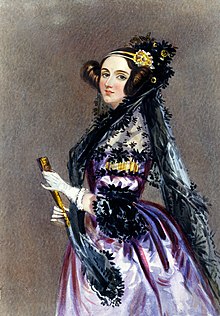
Augusta Ada King, Countess of Lovelace was an English mathematician and writer, chiefly known for her work on Charles Babbage's proposed mechanical general-purpose computer, the Analytical Engine. She was the first to recognise that the machine had applications beyond pure calculation.

The analytical engine was a proposed mechanical general-purpose computer designed by English mathematician and computer pioneer Charles Babbage. It was first described in 1837 as the successor to Babbage's difference engine, which was a design for a simpler mechanical calculator.

Charles Babbage was an English polymath. A mathematician, philosopher, inventor and mechanical engineer, Babbage originated the concept of a digital programmable computer.

The 1840s was a decade of the Gregorian calendar that began on January 1, 1840, and ended on December 31, 1849.
1843 (MDCCCXLIII) was a common year starting on Sunday of the Gregorian calendar and a common year starting on Friday of the Julian calendar, the 1843rd year of the Common Era (CE) and Anno Domini (AD) designations, the 843rd year of the 2nd millennium, the 43rd year of the 19th century, and the 4th year of the 1840s decade. As of the start of 1843, the Gregorian calendar was 12 days ahead of the Julian calendar, which remained in localized use until 1923.
This article contains information about the literary events and publications of 1843.
The year 1822 in science and technology involved some significant events, listed below.
The year 1838 in science and technology involved some significant events, listed below.
The year 1842 in science and technology involved some significant events, listed below.
The year 1791 in science and technology involved some significant events.
The year 1792 in science and technology involved some significant events.
The year 1845 in science and technology involved some significant events, listed below.
The year 1806 in science and technology involved some significant events, listed below.
The year 1859 in science and technology involved some significant events, listed below.

Luigi Federico Menabrea, later made 1st Count Menabrea and 1st Marquess of Valdora, was an Italian statesman, general, diplomat, and mathematician who served as the seventh prime minister of Italy from 1867 to 1869.

Isambard Kingdom Brunel was a British civil engineer and mechanical engineer, who is considered "one of the most ingenious and prolific figures in engineering history", "one of the 19th-century engineering giants", and "one of the greatest figures of the Industrial Revolution, [who] changed the face of the English landscape with his groundbreaking designs and ingenious constructions". Brunel built dockyards, the Great Western Railway (GWR), a series of steamships including the first purpose-built transatlantic steamship, and numerous important bridges and tunnels. His designs revolutionised public transport and modern engineering.
Events from the year 1843 in the United Kingdom.

Bryan Donkin FRS FRAS developed the first paper making machine and created the world's first commercial canning factory. These were the basis for large industries that continue to flourish today. Bryan Donkin was involved with Thomas Telford's Caledonian Canal, Marc and Isambard Brunel's Thames Tunnel, and Charles Babbage's computer. He was an advisor to the government and held in high esteem by his peers.

Note G was a computer algorithm written by Ada Lovelace, and was designed to calculate Bernoulli numbers using the hypothetical analytical engine. Note G is generally agreed to be the first algorithm specifically for a computer, and Lovelace is considered as the first computer programmer as a result. The algorithm was the last note in a series labelled A to G, which she employed as visual aids to accompany her English translation of Luigi Menabrea's 1842 French transcription of Charles Babbage's lecture on the analytical engine at the University of Turin, "Notions sur la machine analytique de Charles Babbage". Lovelace's Note G was never tested, as the engine was never built. Her notes, along with her translation, were published in 1843.










